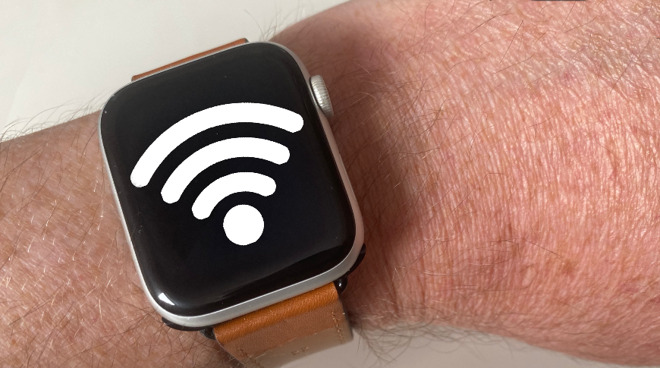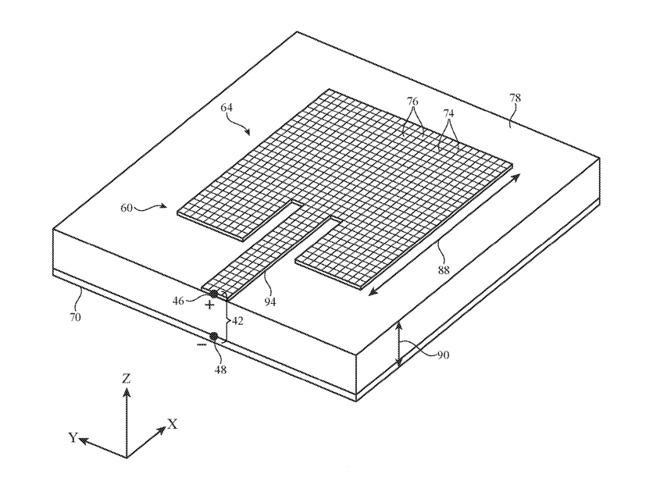Future Apple Watch Wi-Fi & wireless antenna may be embedded in the display
Apple is aiming to bring better Wi-Fi and wireless connectivity to the Apple Watch by creating a wireless antenna array that is integrated into the display.

Future Apple Watches may have improved Wi-Fi antennas underneath the display
Apple has already given the Apple Watch the ability to store music, and most recently its own App Store. Now it's taking another step toward freeing the Watch from needing a companion iPhone, by improving its own Wi-Fi capability.
"Antennas formed from conductive display layers," is a newly-granted US Patent which describes altering the Watch's whole wireless antenna system, and for the better.
Since the very first Apple Watch, the wireless antenna has been a slim component fitted up against the edge of the device. Positioned by the edge of the Watch, it has functioned by leveraging the seams between that edge and both its front face and health-scanner back.
That's a slim seam and the antenna has been a particularly small component inside an extremely tightly packed chassis. The existing implementation works, as the Apple Watch can receive Wi-Fi or wireless networking signals, but it's poor compared to your iPhone.
Apple has a solution. "An antenna may be embedded within the display module," says the patent. "The antenna may include an antenna resonating element formed from a grid of intersecting conductive traces on the dielectric layer [of the screen]."

Detail from the patent showing one possible arrangement of a Wi-Fi antenna
So instead of being one narrow aerial-like antenna, it could be a whole grid taking up part or presumably the whole of the display. Clearly, then, that would give the antenna a greater surface area, and that would improve reception.
However, the Apple Watch display has to be able to work as that display for the user, and it must also be able to register touch from the user. Apple maintains that it could keep doing both, and yet also have this new feature.
"[The Watch] display module is configured to display images through the cover layer and comprises a plurality of stacked dielectric layers coupled to the cover layer," continues the patent. "[And] the antenna is configured to transmit radio-frequency signals through the cover layer."
Apple's patent is at pains to state for the record that this technology could be applied to any number of devices from a computer to a monitor, from an iPad to headphones. However, the detail and the diagrams all concentrate on the Apple Watch, and show various positions for the new antenna.
Those positions differ both horizontally and vertically. The drawings show possible antenna grids taking up various parts of the display, and also varying numbers of layers that could be placed on top of the them.
In theory, the optimum wireless antenna would be a solid unit atop the display and obscuring everything underneath it. That's clearly not acceptable, but Apple is both proposing the technology and aiming for a sweet spot in its position under the display.
While the patent avoids specifying actual figures for how much better Wi-Fi reception could be, depending on the antenna's position, it does provide a "merely illustrative" example chart showing comparative antenna efficiency.

Detail from the patent showing an "illustrative example" of efficiency
"[The top curve marked 138] plots the antenna efficiency of an antenna having an antenna resonating element formed from a solid conductor," says the patent. "[The lower curve marked 140] plots the antenna efficiency of... a resonating element formed using [a] grid."
The patent notes that a grid "slightly reduces the antenna efficiency" but notes that it "still exhibits a satisfactory antenna efficiency."
While Apple files for and obtains many patents, it is not guaranteed that any will result in future products or features. However, the forthcoming Apple Watch Series 6 has separately been rumored to include better wireless connectivity and it's possible that this is how Apple will achieve that.
This patent is credited to five inventors, Siwen Yong, Yi Jiang, Wu Jiangfeng, Lijun Zhang, and Mattia Pascolini. Each of the five have multiple previous patents in related areas, including "Antennas in patterned conductive layers," which is credited to all of them.

Future Apple Watches may have improved Wi-Fi antennas underneath the display
Apple has already given the Apple Watch the ability to store music, and most recently its own App Store. Now it's taking another step toward freeing the Watch from needing a companion iPhone, by improving its own Wi-Fi capability.
"Antennas formed from conductive display layers," is a newly-granted US Patent which describes altering the Watch's whole wireless antenna system, and for the better.
Since the very first Apple Watch, the wireless antenna has been a slim component fitted up against the edge of the device. Positioned by the edge of the Watch, it has functioned by leveraging the seams between that edge and both its front face and health-scanner back.
That's a slim seam and the antenna has been a particularly small component inside an extremely tightly packed chassis. The existing implementation works, as the Apple Watch can receive Wi-Fi or wireless networking signals, but it's poor compared to your iPhone.
Apple has a solution. "An antenna may be embedded within the display module," says the patent. "The antenna may include an antenna resonating element formed from a grid of intersecting conductive traces on the dielectric layer [of the screen]."

Detail from the patent showing one possible arrangement of a Wi-Fi antenna
So instead of being one narrow aerial-like antenna, it could be a whole grid taking up part or presumably the whole of the display. Clearly, then, that would give the antenna a greater surface area, and that would improve reception.
However, the Apple Watch display has to be able to work as that display for the user, and it must also be able to register touch from the user. Apple maintains that it could keep doing both, and yet also have this new feature.
"[The Watch] display module is configured to display images through the cover layer and comprises a plurality of stacked dielectric layers coupled to the cover layer," continues the patent. "[And] the antenna is configured to transmit radio-frequency signals through the cover layer."
Apple's patent is at pains to state for the record that this technology could be applied to any number of devices from a computer to a monitor, from an iPad to headphones. However, the detail and the diagrams all concentrate on the Apple Watch, and show various positions for the new antenna.
Those positions differ both horizontally and vertically. The drawings show possible antenna grids taking up various parts of the display, and also varying numbers of layers that could be placed on top of the them.
In theory, the optimum wireless antenna would be a solid unit atop the display and obscuring everything underneath it. That's clearly not acceptable, but Apple is both proposing the technology and aiming for a sweet spot in its position under the display.
While the patent avoids specifying actual figures for how much better Wi-Fi reception could be, depending on the antenna's position, it does provide a "merely illustrative" example chart showing comparative antenna efficiency.

Detail from the patent showing an "illustrative example" of efficiency
"[The top curve marked 138] plots the antenna efficiency of an antenna having an antenna resonating element formed from a solid conductor," says the patent. "[The lower curve marked 140] plots the antenna efficiency of... a resonating element formed using [a] grid."
The patent notes that a grid "slightly reduces the antenna efficiency" but notes that it "still exhibits a satisfactory antenna efficiency."
While Apple files for and obtains many patents, it is not guaranteed that any will result in future products or features. However, the forthcoming Apple Watch Series 6 has separately been rumored to include better wireless connectivity and it's possible that this is how Apple will achieve that.
This patent is credited to five inventors, Siwen Yong, Yi Jiang, Wu Jiangfeng, Lijun Zhang, and Mattia Pascolini. Each of the five have multiple previous patents in related areas, including "Antennas in patterned conductive layers," which is credited to all of them.

Comments